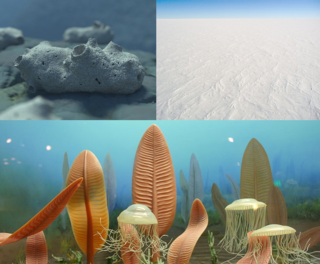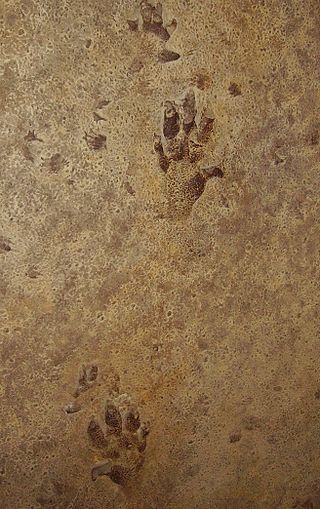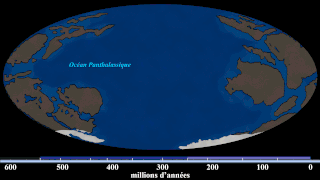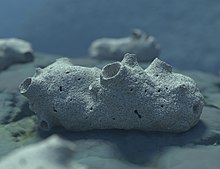The timeline of the evolutionary history of life represents the current scientific theory outlining the major events during the development of life on planet Earth. Dates in this article are consensus estimates based on scientific evidence, mainly fossils.

A fossil is any preserved remains, impression, or trace of any once-living thing from a past geological age. Examples include bones, shells, exoskeletons, stone imprints of animals or microbes, objects preserved in amber, hair, petrified wood and DNA remnants. The totality of fossils is known as the fossil record.

The Neoproterozoic Era is the unit of geologic time from 1 billion to 538.8 million years ago.
The cloudinids, an early metazoan family containing the genera Acuticocloudina, Cloudina and Conotubus, lived in the late Ediacaran period about 550 million years ago. and became extinct at the base of the Cambrian. They formed millimetre-scale conical fossils consisting of calcareous cones nested within one another; the appearance of the organism itself remains unknown. The name Cloudina honors the 20th-century geologist and paleontologist Preston Cloud.

Sponges, the members of the phylum Porifera, are a basal animal clade as a sister of the diploblasts. They are multicellular organisms that have bodies full of pores and channels allowing water to circulate through them, consisting of jelly-like mesohyl sandwiched between two thin layers of cells.

Ausia fenestrata is a curious Ediacaran period fossil represented by only one specimen 5 cm long from the Nama Group, a Vendian to Cambrian group of stratigraphic sequences deposited in the Nama foreland basin in central and southern Namibia. It has similarity to Burykhia from Ediacaran (Vendian) siliciclastic sediments exposed on the Syuzma River of northern Russia. This fossil is of the form of an elongate bag-like sandstone cast tapering to a cone on one end. The surface of the fossil is covered with oval depressions ("windows") regularly spaced over the surface in the manner of concentric/parallel rows. The taxonomic identity of Ausia is unresolved.

A trace fossil, also known as an ichnofossil, is a fossil record of biological activity but not the preserved remains of the plant or animal itself. Trace fossils contrast with body fossils, which are the fossilized remains of parts of organisms' bodies, usually altered by later chemical activity or mineralization. The study of such trace fossils is ichnology and is the work of ichnologists.

The Doushantuo Formation is a geological formation in western Hubei, eastern Guizhou, southern Shaanxi, central Jiangxi, and other localities in China. It is known for the fossil Lagerstätten in Zigui in Hubei, Xiuning in Anhui, and Weng'an in Guizhou, as one of the oldest beds to contain minutely preserved microfossils, phosphatic fossils that are so characteristic they have given their name to "Doushantuo type preservation". The formation, whose deposits date back to the Early and Middle Ediacaran, is of particular interest because it covers the poorly understood interval of time between the end of the Cryogenian geological period and the more familiar fauna of the Late Ediacaran Avalon explosion, as well as due to its microfossils' potential utility as biostratigraphical markers. Taken as a whole, the Doushantuo Formation ranges from about 635 Ma at its base to about 551 Ma at its top, with the most fossiliferous layer predating by perhaps five Ma the earliest of the 'classical' Ediacaran faunas from Mistaken Point on the Avalon Peninsula of Newfoundland, and recording conditions up to a good forty to fifty million years before the Cambrian explosion at the beginning of the Phanerozoic.

The Cryogenian is a geologic period that lasted from 720 to 635 million years ago. It forms the second geologic period of the Neoproterozoic Era, preceded by the Tonian Period and followed by the Ediacaran.

The Tonian is the first geologic period of the Neoproterozoic Era. It lasted from 1000 to 720 Mya. Instead of being based on stratigraphy, these dates are defined by the ICS based on radiometric chronometry. The Tonian is preceded by the Stenian Period of the Mesoproterozoic Era and followed by the Cryogenian.

The Karoo Supergroup is the most widespread stratigraphic unit in Africa south of the Kalahari Desert. The supergroup consists of a sequence of units, mostly of nonmarine origin, deposited between the Late Carboniferous and Early Jurassic, a period of about 120 million years.

A fossil track or ichnite is a fossilized footprint. This is a type of trace fossil. A fossil trackway is a sequence of fossil tracks left by a single organism. Over the years, many ichnites have been found, around the world, giving important clues about the behaviour of the animals that made them. For instance, multiple ichnites of a single species, close together, suggest 'herd' or 'pack' behaviour of that species.

Ichthyornithes is an extinct group of toothed avialans very closely related to the common ancestor of all modern birds. They are known from fossil remains found throughout the late Cretaceous period of North America, though only two genera, Ichthyornis and Janavis, are represented by complete enough fossils to have been named. Ichthyornitheans became extinct at the Cretaceous–Paleogene boundary, along with enantiornitheans, all other non-avian dinosaurs, and many other animal and plant groups.
Namapoikia rietoogensis is among the earliest known animals to produce a calcareous skeleton. Known from the Ediacaran period, before the Cambrian explosion of calcifying animals, the long-lived organism grew up to a metre in diameter and resembles a colonial sponge. It was an encruster, filling vertical fissures in the reefs in which it originally grew.

Stahleckeria is an extinct genus of Middle Triassic (Ladinian) dicynodonts. It lived about 240 million years ago in what is now Brazil and Namibia. As a member of the group Kannemeyeriiformes, it was similar to the genus Kannemeyeria. The genus is known from the type species Stahleckeria potens, which was first collected from the Ladinian-age Santa Maria Formation in the Paleorrota fossil site of Brazil. Stahleckeria was named in honor of Rudolf Stahlecker, who discovered the first specimens during a 1935 expedition led by paleontologist Friedrich von Huene to the Chiniquá fossil site.

The Ediacaranbiota is a taxonomic period classification that consists of all life forms that were present on Earth during the Ediacaran Period. These were composed of enigmatic tubular and frond-shaped, mostly sessile, organisms. Trace fossils of these organisms have been found worldwide, and represent the earliest known complex multicellular organisms.

Marine invertebrates are the invertebrates that live in marine habitats. Invertebrate is a blanket term that includes all animals apart from the vertebrate members of the chordate phylum. Invertebrates lack a vertebral column, and some have evolved a shell or a hard exoskeleton. As on land and in the air, marine invertebrates have a large variety of body plans, and have been categorised into over 30 phyla. They make up most of the macroscopic life in the oceans.
The small shelly fauna, small shelly fossils (SSF), or early skeletal fossils (ESF) are mineralized fossils, many only a few millimetres long, with a nearly continuous record from the latest stages of the Ediacaran to the end of the Early Cambrian Period. They are very diverse, and there is no formal definition of "small shelly fauna" or "small shelly fossils". Almost all are from earlier rocks than more familiar fossils such as trilobites. Since most SSFs were preserved by being covered quickly with phosphate and this method of preservation is mainly limited to the late Ediacaran and early Cambrian periods, the animals that made them may actually have arisen earlier and persisted after this time span.
The Cambrian explosion, Cambrian radiation,Cambrian diversification, or the Biological Big Bang refers to an interval of time approximately 538.8 ± 0.2 million years ago in the Cambrian Period when practically all major animal phyla started appearing in the fossil record. It lasted for about 13 – 25 million years and resulted in the divergence of most modern metazoan phyla. The event was accompanied by major diversification in other groups of organisms as well.
The Kaigas glaciation was a hypothesized snowball earth event in the Neoproterozoic Era, preceding the Sturtian glaciation. Its occurrence was inferred based on the interpretation of Kaigas Formation conglomerates in the stratigraphy overlying the Kalahari Craton as correlative with pre-Sturtian Numees formation glacial diamictites. However, the Kaigas formation was later determined to be non-glacial, and a Sturtian age was assigned to the Numees diamictites. Thus, there is no longer any evidence for a Neoproterozoic glaciation prior to the Sturtian snowball earth event.















